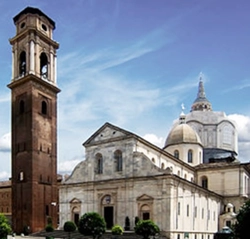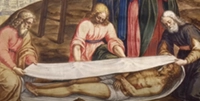
Shroud of Turin
The Shroud of Turin is the most fabled and studied of all Christian relics. It is a length of linen that for centuries has been purported to be the burial garment of Jesus Christ. It has been preserved since 1578 in the royal chapel of the cathedral of San Giovanni Battista in Turin, Italy.

The cloth has two faint brownish images, those of the back and front of a gaunt, sunken-eyed man. The images contain markings that allegedly correspond to the crucifixion wounds of Jesus, including thorn marks on the head, lacerations (as if from flogging) on the back, bruises on the shoulders, and various stains of what was thought to be blood.
The shroud may have first emerged historically in 1354, when it is recorded in the hands of a famed knight, Geoffroi de Charny, seigneur de Lirey. In 1389, when it went on exhibition, it was denounced as false by the local bishop of Troyes. The Avignon antipope Clement VII did not express an opinion on the shroud’s authenticity, but sanctioned its use as an object of devotion, requiring that it be exhibited as an “image or representation” of the true shroud. Subsequent popes from Julius II on, however, took its authenticity for granted.
In 1453 Geoffroi de Charnay’s granddaughter Marguerite gave the shroud to the house of Savoy at Chambéry, and there it was damaged by fire and water in 1532. Later, it was moved to the new Savoyard capital of Turin in 1578, where it has been ever since. It has rarely been exhibited publicly, as on the marriage of Prince Umberto in 1931 and on the 400th anniversary of its arrival in Turin (1978). In 1998 and 2000 Pope John Paul II arranged for public viewings, calling the shroud "a mirror of the Gospel." Pope Benedict XVI similarly arranged a public display in 2010, and Pope Francis made a pilgrimage to see it in 2015.
People from all Christian denominations are curious about the Shroud and hold a variety of opinions as to its meaning. Whether it is a true relic of Jesus, the image of another ancient man, or some, so-far, indecipherable hoax, study of this item can prove truly fascinating. Also, regardless of its true provenance, it serves as a gripping reminder of the Savior's passion.

